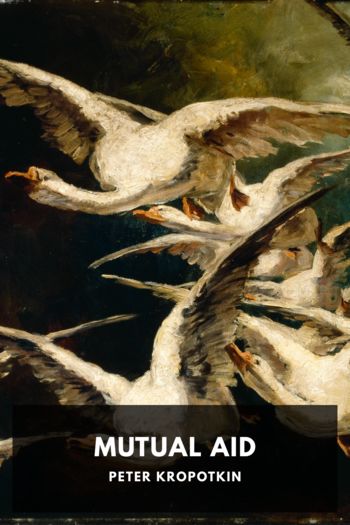Mutual Aid, Peter Kropotkin [fiction novels to read .txt] 📗

- Author: Peter Kropotkin
Book online «Mutual Aid, Peter Kropotkin [fiction novels to read .txt] 📗». Author Peter Kropotkin
It is now known, and scarcely contested, that the village community was not a specific feature of the Slavonians, nor even of the ancient Teutons. It prevailed in England during both the Saxon and Norman times, and partially survived till the last century;116 it was at the bottom of the social organization of old Scotland, old Ireland, and old Wales. In France, the communal possession and the communal allotment of arable land by the village folkmote persisted from the first centuries of our era till the times of Turgot, who found the folkmotes “too noisy” and therefore abolished them. It survived Roman rule in Italy, and revived after the fall of the Roman Empire. It was the rule with the Scandinavians, the Slavonians, the Finns (in the pittäyä, as also, probably, the kihla-kunta), the Coures, and the Lives. The village community in India—past and present, Aryan and non-Aryan—is well known through the epoch-making works of Sir Henry Maine; and Elphinstone has described it among the Afghans. We also find it in the Mongolian oulous, the Kabyle thaddart, the Javanese dessa, the Malayan kota or tofa, and under a variety of names in Abyssinia, the Sudan, in the interior of Africa, with natives of both Americas, with all the small and large tribes of the Pacific archipelagoes. In short, we do not know one single human race or one single nation which has not had its period of village communities. This fact alone disposes of the theory according to which the village community in Europe would have been a servile growth. It is anterior to serfdom, and even servile submission was powerless to break it. It was a universal phase of evolution, a natural outcome of the clan organization, with all those stems, at least, which have played, or play still, some part in history.117
It was a natural growth, and an absolute uniformity in its structure was therefore not possible. As a rule, it was a union between families considered as of common descent and owning a certain territory in common. But with some stems, and under certain circumstances, the families used to grow very numerous before they threw off new buds in the shape of new families; five, six, or seven generations continued to live under the same roof, or within the same enclosure, owning their joint household and cattle in common, and taking their meals at the common hearth. They kept in such case to what ethnology knows as the “joint family,” or the “undivided household,” which we still see all over China, in India, in the South Slavonian zadruga, and occasionally find in Africa, in America, in Denmark, in North Russia, and West France.118 With other stems, or in other circumstances, not yet well specified, the families did not attain the same proportions; the grandsons, and occasionally the sons, left the household as soon as they were married, and each of them started a new cell of his own. But, joint or not, clustered together or scattered in the woods, the families remained united into village communities; several villages were grouped into tribes; and the tribes joined into confederations. Such was the social organization which developed among the so-called “barbarians,” when they began to settle more or less permanently in Europe.
A very long evolution was required before the gentes, or clans, recognized the separate existence of a patriarchal family in a separate hut; but even after that had been recognized, the clan, as a rule, knew no personal inheritance of property. The few things which might have belonged personally to the individual were either destroyed on his grave or buried with him. The village community, on the contrary, fully recognized the private accumulation of wealth within the family and its hereditary transmission. But wealth was conceived exclusively in the shape of movable property, including cattle, implements, arms, and the dwelling house which—“like all things that can be destroyed by fire”—belonged to the same category.119 As to private property in land, the village community did not, and could not, recognize anything of the kind, and, as a rule, it does not recognize it now. The land was the common property of the tribe, or of the whole stem, and the village community itself owned its part of the tribal territory so long only as the tribe did not claim a redistribution of the village allotments. The clearing of the woods and the breaking of the prairies being mostly done by the communities or, at least, by the joint work of several families—always with the consent of the community—the cleared plots were held by each family for a term of four, twelve, or twenty years, after which term they were treated as parts of the arable land owned in common. Private property, or possession “forever” was as incompatible with the very principles and the religious conceptions of the village community as it was with the principles of the gens; so that a long influence of the Roman law and the Christian Church, which soon accepted the Roman principles, were required to accustom the barbarians to the idea of private property in land being possible.120 And yet, even when such property, or possession for an unlimited time, was recognized, the owner of a separate estate remained a co-proprietor in the waste lands, forests, and grazing-grounds. Moreover,





Comments (0)